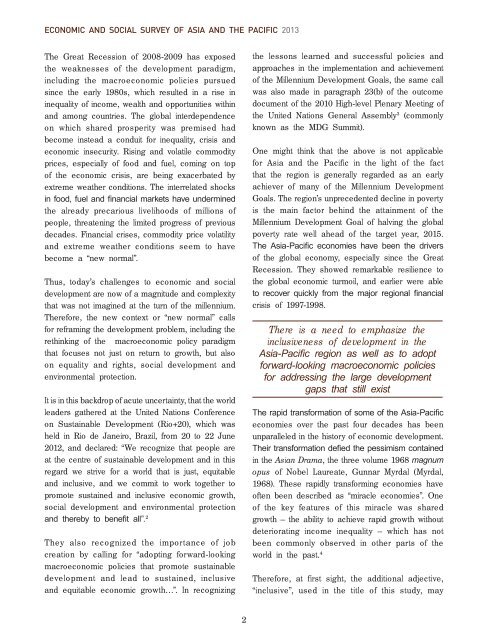Full Report - Subregional Office for East and North-East Asia - escap
Full Report - Subregional Office for East and North-East Asia - escap
Full Report - Subregional Office for East and North-East Asia - escap
You also want an ePaper? Increase the reach of your titles
YUMPU automatically turns print PDFs into web optimized ePapers that Google loves.
ECONOMIC AND SOCIAL SURVEY OF ASIA AND THE PACIFIC 2013<br />
The Great Recession of 2008-2009 has exposed<br />
the weaknesses of the development paradigm,<br />
including the macroeconomic policies pursued<br />
since the early 1980s, which resulted in a rise in<br />
inequality of income, wealth <strong>and</strong> opportunities within<br />
<strong>and</strong> among countries. The global interdependence<br />
on which shared prosperity was premised had<br />
become instead a conduit <strong>for</strong> inequality, crisis <strong>and</strong><br />
economic insecurity. Rising <strong>and</strong> volatile commodity<br />
prices, especially of food <strong>and</strong> fuel, coming on top<br />
of the economic crisis, are being exacerbated by<br />
extreme weather conditions. The interrelated shocks<br />
in food, fuel <strong>and</strong> financial markets have undermined<br />
the already precarious livelihoods of millions of<br />
people, threatening the limited progress of previous<br />
decades. Financial crises, commodity price volatility<br />
<strong>and</strong> extreme weather conditions seem to have<br />
become a “new normal”.<br />
Thus, today’s challenges to economic <strong>and</strong> social<br />
development are now of a magnitude <strong>and</strong> complexity<br />
that was not imagined at the turn of the millennium.<br />
There<strong>for</strong>e, the new context or “new normal” calls<br />
<strong>for</strong> reframing the development problem, including the<br />
rethinking of the macroeconomic policy paradigm<br />
that focuses not just on return to growth, but also<br />
on equality <strong>and</strong> rights, social development <strong>and</strong><br />
environmental protection.<br />
It is in this backdrop of acute uncertainty, that the world<br />
leaders gathered at the United Nations Conference<br />
on Sustainable Development (Rio+20), which was<br />
held in Rio de Janeiro, Brazil, from 20 to 22 June<br />
2012, <strong>and</strong> declared: “We recognize that people are<br />
at the centre of sustainable development <strong>and</strong> in this<br />
regard we strive <strong>for</strong> a world that is just, equitable<br />
<strong>and</strong> inclusive, <strong>and</strong> we commit to work together to<br />
promote sustained <strong>and</strong> inclusive economic growth,<br />
social development <strong>and</strong> environmental protection<br />
<strong>and</strong> thereby to benefit all”. 2<br />
They also recognized the importance of job<br />
creation by calling <strong>for</strong> “adopting <strong>for</strong>ward-looking<br />
macroeconomic policies that promote sustainable<br />
development <strong>and</strong> lead to sustained, inclusive<br />
<strong>and</strong> equitable economic growth…”. In recognizing<br />
the lessons learned <strong>and</strong> successful policies <strong>and</strong><br />
approaches in the implementation <strong>and</strong> achievement<br />
of the Millennium Development Goals, the same call<br />
was also made in paragraph 23(b) of the outcome<br />
document of the 2010 High-level Plenary Meeting of<br />
the United Nations General Assembly 3 (commonly<br />
known as the MDG Summit).<br />
One might think that the above is not applicable<br />
<strong>for</strong> <strong>Asia</strong> <strong>and</strong> the Pacific in the light of the fact<br />
that the region is generally regarded as an early<br />
achiever of many of the Millennium Development<br />
Goals. The region’s unprecedented decline in poverty<br />
is the main factor behind the attainment of the<br />
Millennium Development Goal of halving the global<br />
poverty rate well ahead of the target year, 2015.<br />
The <strong>Asia</strong>-Pacific economies have been the drivers<br />
of the global economy, especially since the Great<br />
Recession. They showed remarkable resilience to<br />
the global economic turmoil, <strong>and</strong> earlier were able<br />
to recover quickly from the major regional financial<br />
crisis of 1997-1998.<br />
There is a need to emphasize the<br />
inclusiveness of development in the<br />
<strong>Asia</strong>-Pacific region as well as to adopt<br />
<strong>for</strong>ward-looking macroeconomic policies<br />
<strong>for</strong> addressing the large development<br />
gaps that still exist<br />
The rapid trans<strong>for</strong>mation of some of the <strong>Asia</strong>-Pacific<br />
economies over the past four decades has been<br />
unparalleled in the history of economic development.<br />
Their trans<strong>for</strong>mation defied the pessimism contained<br />
in the <strong>Asia</strong>n Drama, the three volume 1968 magnum<br />
opus of Nobel Laureate, Gunnar Myrdal (Myrdal,<br />
1968). These rapidly trans<strong>for</strong>ming economies have<br />
often been described as “miracle economies”. One<br />
of the key features of this miracle was shared<br />
growth – the ability to achieve rapid growth without<br />
deteriorating income inequality – which has not<br />
been commonly observed in other parts of the<br />
world in the past. 4<br />
There<strong>for</strong>e, at first sight, the additional adjective,<br />
“inclusive”, used in the title of this study, may<br />
2












